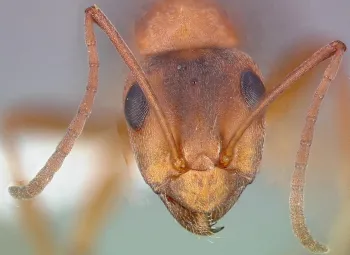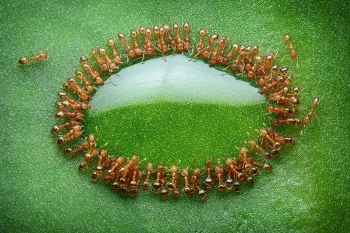
They can’t help it, that trail of ants crawling up a kitchen cabinet. The determined critters head inside to escape cold, wet winter days or hot, dry summer conditions. But our sympathies don’t extend to safe harboring ant armies. Nor are we happy to see them in the garden keeping aphids alive.
There are 12,400 ant species in the world, of which 270 species live in California.
The most common is the Argentine ant, Linepithema humile. A second less common but important species is the Carpenter ant, Camponotus species. Carpenter ants don’t eat wood like termites; however, they hollow it out to nest and thus cause damage inside.

Ant biology and behavior has long inspired science projects and allegories. But what we want to know is how to deal with these space invaders.
Outside, ants are beneficial insects when they recycle nutrients, aerate the soil, and feed on fleas, termites, and other pests in the garden. But when they help aphids, mealybugs, and scale survive, they are garden pests. Inside, they are simply unwelcome.
Whether you want to eliminate ants in the house or control them in the garden, the basics are the same: remove access, resources, and nesting sites.

Eliminating ants in the house
First, know what you’ve got. All ants differ from termites in three main ways: Ants have tiny waists, hind wings smaller than front wings, and front antennae with elbows. Termites have broad waists, equally sized wings, and straight front antennae. Argentine ants are about 1/8th inch long and dull brown. Carpenter ants are ¼ to ½ inch long, black or black and red.
- Breathe a sigh of relief if you have ants, not termites. You can vacuum the ant trails or wipe them up with soapy water and spray with window cleaner to eliminate them and wash away their scent trail. These techniques work better than insecticide sprays and leave no residual toxicity.
- Look for ant nests in potted plants. Take infected pots outside, submerge them in a solution of one to two tablespoons of insecticidal soap per quart of water, and allow the solution to cover the soil for 20 minutes or more.
- Remove whatever attracted the ants. Mop, scrub, and remove trash. Store food items, including pet food, in closed containers. Fix leaky faucets; they attract thirsty ants.
- Then, discover the entry points. Eliminate caulk holes, crevices, or cracks in foundations or walls by caulking openings or plugging them with petroleum jelly.
Ants are outdoor critters, so although you can eliminate them inside if you want to keep them out, you need to take action outside.
In the garden
Focus on removing or managing food sources, including aphid-infested bushes or trees with ripened fruit near your house. Eliminate nearby nesting spots by moving plants and mulch at least a foot from the foundation or even farther to be fire-smart.
If that doesn’t stop the invasion, and if you’re concerned about aphids, mealybugs, and scale, consider using slow-acting bait stations or gel bait outside. These pesticides don’t work immediately; you’ll likely need to continue wiping up scouts and trails inside for a few days until the worker ants have taken the bait to the colony. But baits are the only type of insecticide recommended in most situations and are the safest and easiest to use. Use them indoors only for a very serious infestation, and keep in mind they could attract outside ants inside. Instead, place baits outdoors near ant trails and nest openings.
Look for Argentine ant nests in shallow mounds and Carpenter ant nests in tree stumps and other wood with sawdust-like frass deposits alongside.
It is unrealistic and impractical to attempt to totally eliminate ants outdoors, though. Instead, focus on excluding ants from buildings or valuable plants. And remember—ants can be annoying, but they can also play a beneficial role in the garden.
By Barbara Robertson, March 15, 2025

